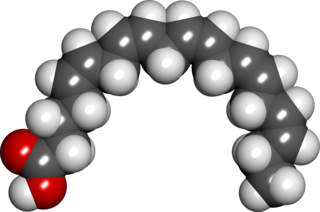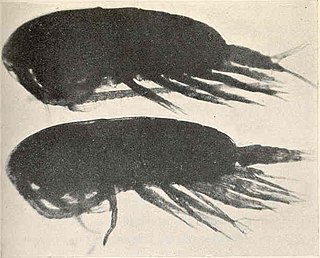
In nutrition, biology, and chemistry, fat usually means any ester of fatty acids, or a mixture of such compounds, most commonly those that occur in living beings or in food.
Omega−3 fatty acids, also called Omega−3 oils, ω−3 fatty acids or n−3 fatty acids, are polyunsaturated fatty acids (PUFAs) characterized by the presence of a double bond, three atoms away from the terminal methyl group in their chemical structure. They are widely distributed in nature, being important constituents of animal lipid metabolism, and they play an important role in the human diet and in human physiology. The three types of omega−3 fatty acids involved in human physiology are α-linolenic acid (ALA), eicosapentaenoic acid (EPA) and docosahexaenoic acid (DHA). ALA can be found in plants, while DHA and EPA are found in algae and fish. Marine algae and phytoplankton are primary sources of omega−3 fatty acids. DHA and EPA accumulate in fish that eat these algae. Common sources of plant oils containing ALA include walnuts, edible seeds, and flaxseeds as well as hempseed oil, while sources of EPA and DHA include fish and fish oils, and algae oil.

Waxes are a diverse class of organic compounds that are lipophilic, malleable solids near ambient temperatures. They include higher alkanes and lipids, typically with melting points above about 40 °C (104 °F), melting to give low viscosity liquids. Waxes are insoluble in water but soluble in nonpolar organic solvents such as hexane, benzene and chloroform. Natural waxes of different types are produced by plants and animals and occur in petroleum.
Essential fatty acids, or EFAs, are fatty acids that humans and other animals must ingest because the body requires them for good health, but cannot synthesize them.

Cod liver oil is a dietary supplement derived from liver of cod fish (Gadidae). As with most fish oils, it contains the omega-3 fatty acids eicosapentaenoic acid (EPA) and docosahexaenoic acid (DHA), and also vitamin A and vitamin D. Historically, it was given to children because vitamin D had been shown to prevent rickets, a consequence of vitamin D deficiency.
An unsaturated fat is a fat or fatty acid in which there is at least one double bond within the fatty acid chain. A fatty acid chain is monounsaturated if it contains one double bond, and polyunsaturated if it contains more than one double bond.

Palmitic acid is a fatty acid with a 16-carbon chain. It is the most common saturated fatty acid found in animals, plants and microorganisms. Its chemical formula is CH3(CH2)14COOH, and its C:D ratio is 16:0. It is a major component of palm oil from the fruit of Elaeis guineensis, making up to 44% of total fats. Meats, cheeses, butter, and other dairy products also contain palmitic acid, amounting to 50–60% of total fats.

Oleic acid is a fatty acid that occurs naturally in various animal and vegetable fats and oils. It is an odorless, colorless oil, although commercial samples may be yellowish. In chemical terms, oleic acid is classified as a monounsaturated omega-9 fatty acid, abbreviated with a lipid number of 18:1 cis-9, and a main product of Δ9-desaturase. It has the formula CH3−(CH2)7−CH=CH−(CH2)7−COOH. The name derives from the Latin word oleum, which means oil. It is the most common fatty acid in nature. The salts and esters of oleic acid are called oleates. It is a common component of oils, and thus occurs in many types of food, as well as in soap.
Fish oil is oil derived from the tissues of oily fish. Fish oils contain the omega-3 fatty acids eicosapentaenoic acid (EPA) and docosahexaenoic acid (DHA), precursors of certain eicosanoids that are known to reduce inflammation in the body and improve hypertriglyceridemia. There has been a great deal of controversy in the 21st century about the role of fish oil in cardiovascular disease, with recent meta-analyses reaching different conclusions about its potential impact.
In biochemistry and nutrition, a monounsaturated fat is a fat that contains a monounsaturated fatty acid (MUFA), a subclass of fatty acid characterized by having a double bond in the fatty acid chain with all of the remaining carbon atoms being single-bonded. By contrast, polyunsaturated fatty acids (PUFAs) have more than one double bond.

Eicosapentaenoic acid is an omega-3 fatty acid. In physiological literature, it is given the name 20:5(n-3). It also has the trivial name timnodonic acid. In chemical structure, EPA is a carboxylic acid with a 20-carbon chain and five cis double bonds; the first double bond is located at the third carbon from the omega end.

Docosahexaenoic acid (DHA) is an omega-3 fatty acid that is a primary structural component of the human brain, cerebral cortex, skin, and retina. It is given the fatty acid notation 22:6(n-3). It can be synthesized from alpha-linolenic acid or obtained directly from maternal milk, fatty fish, fish oil, or algae oil. The consumption of DHA contributes to numerous physiological benefits, including cognition. As the primary structural component of nerve cells in the brain, the function of DHA is to support neuronal conduction and to allow optimal function of neuronal membrane proteins.
Fatty alcohols (or long-chain alcohols) are usually high-molecular-weight, straight-chain primary alcohols, but can also range from as few as 4–6 carbons to as many as 22–26, derived from natural fats and oils. The precise chain length varies with the source. Some commercially important fatty alcohols are lauryl, stearyl, and oleyl alcohols. They are colourless oily liquids (for smaller carbon numbers) or waxy solids, although impure samples may appear yellow. Fatty alcohols usually have an even number of carbon atoms and a single alcohol group (–OH) attached to the terminal carbon. Some are unsaturated and some are branched. They are widely used in industry. As with fatty acids, they are often referred to generically by the number of carbon atoms in the molecule, such as "a C12 alcohol", that is an alcohol having 12 carbons, for example dodecanol.
Omega-9 fatty acids are a family of unsaturated fatty acids which have in common a final carbon–carbon double bond in the omega−9 position; that is, the ninth bond from the methyl end of the fatty acid.

Caprylic acid, also known under the systematic name octanoic acid or C8 Acid, is a saturated fatty acid, medium-chain fatty acid (MCFA). It has the structural formula H3C−(CH2)6−COOH, and is a colorless oily liquid that is minimally soluble in water with a slightly unpleasant rancid-like smell and taste. Salts and esters of octanoic acid are known as octanoates or caprylates. It is a common industrial chemical, which is produced by oxidation of the C8 aldehyde. Its compounds are found naturally in the milk of various mammals and as a minor constituent of coconut oil and palm kernel oil.
Docosapentaenoic acid (DPA) designates any straight open chain polyunsaturated fatty acid (PUFA) which contains 22 carbons and 5 double bonds. DPA is primarily used to designate two isomers, all-cis-4,7,10,13,16-docosapentaenoic acid and all-cis-7,10,13,16,19-docosapentaenoic acid. They are also commonly termed n-6 DPA and n-3 DPA, respectively; these designations describe the position of the double bond being 6 or 3 carbons closest to the (omega) carbon at the methyl end of the molecule and is based on the biologically important difference that n-6 and n-3 PUFA are separate PUFA classes, i.e. the omega-6 fatty acids and omega-3 fatty acids, respectively. Mammals, including humans, can not interconvert these two classes and therefore must obtain dietary essential PUFA fatty acids from both classes in order to maintain normal health.

Calanus finmarchicus is a species of copepod and a component of the zooplankton, which is found in enormous amounts in the northern Atlantic Ocean.

Omega-3-acid ethyl esters are a mixture of ethyl eicosapentaenoic acid and ethyl docosahexaenoic acid, which are ethyl esters of the omega-3 fatty acids eicosapentaenoic acid (EPA) and docosahexaenoic acid (DHA) found in fish oil. Together with dietary changes, they are used to treat high blood triglycerides which may reduce the risk of pancreatitis. They are generally less preferred than statins, and use is not recommended by NHS Scotland as the evidence does not support a decreased risk of heart disease. Omega-3-acid ethyl esters are taken by mouth.
Omega-3 carboxylic acids (Epanova) is a formerly marketed yet still not an Food And Drug Administration (FDA) approved prescription medication–since taken off market by the manufacturer–used alongside a low fat and low cholesterol diet that lowers high triglyceride (fat) levels in adults with very high levels. This was the third class of fish oil-based drug, after omega-3 acid ethyl esters and ethyl eicosapentaenoic acid (Vascepa), to be approved for use as a drug. The first approval by US Food and Drug Administration was granted 05 May 2014. These fish oil drugs are similar to fish oil dietary supplements, but the ingredients are better controlled and have been tested in clinical trials. Specifically, Epanova contained at least 850 mg omega-3-acid ethyl esters per 1 g capsule.











